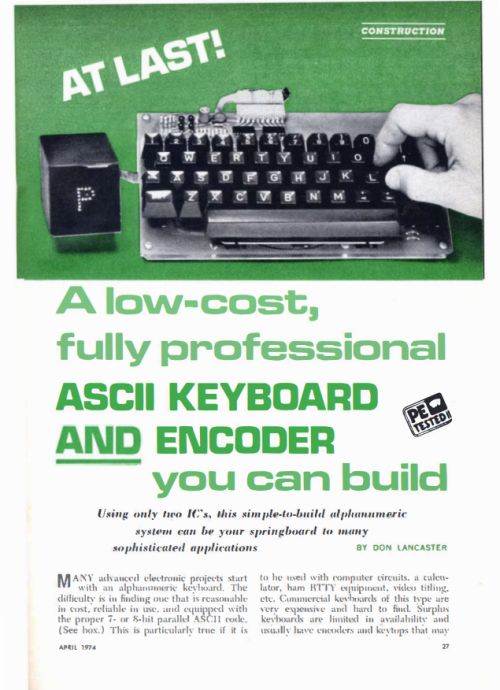
Spread by Dorothy Yule in Upper & Lowercase Magazine Vol 2, No. 4, 1975. via

Spread by Dorothy Yule in Upper & Lowercase Magazine Vol 2, No. 4, 1975. via


These are IBM’s first computers: IBM 5100 (1975) and IBM 5110 (1978).
The 5100 had 256 characters but half of the characters were just underscored versions of the other half. It used IBM’s mega obscure EBCD encoding instead of ASCII. IBM 5110 dropped most of the underscored characters, which made room for semi-graphic characters. Encoding was changed to the slightly less obscure EBCDIC, and there were 14 localized character sets with 12 characters each.
Character set photos from Voidstar, where there are also more details about the character sets.
Southwest Technical’s 6800 computer and the CT-64 terminal, and a photo of its 64×16 textmode. Launched in 1975. First image from Creative Computing and second one from here.

Article in Popular Electronics 1974 to build an ASCII-compatible keyboard for 40 USD. Posted on archive.org as Apple documentation, so this was presumably used for the Apple I.



From a 1975 book called Happenting on Travel On, written by Carole Spearin McCauley. Features computer generated text, text graphics, source code, etc. via James Ryan
LetraTime, a German magazine from 1975. This cover won ITC’s first Upper and Lower Case International Typographics Competition.
More info. h/t: Tim Koch
2024-update: Christof Gassner seems to the be designer.
Foucault by Kohei Sugiura from Koichi Toyosaki, Suna no Kao (Face on the Sand), Ozawa Shoten, 1975. h/t: Takashi Kawano
Next up from the IFA archives, the introduction of teletext TVs in 1975. Loved teletext, was ahead of its time. http://ift.tt/1ACvWyb
— Martyn Williams (@martyn_williams) September 4, 2014
Archeological maps in ASCII from 1975. A good way of visualizing spatial and other information simultaneously, and obviously a forerunner to both text adventure maps and modern cartography, as noted here.
Also check the typewriter maps, fat font for text-mode infovis & the virus map.